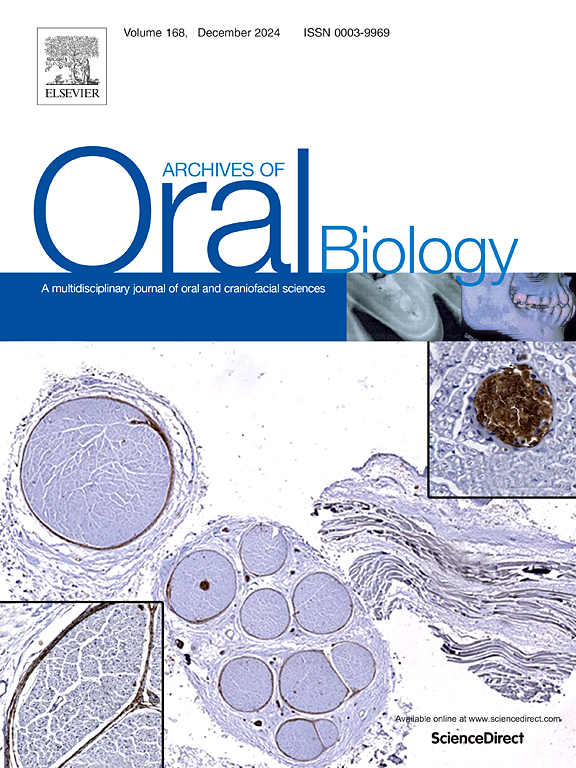匹罗卡品和异丙肾上腺素刺激大鼠唾液的定量蛋白质组学研究。
IF 2.2
4区 医学
Q2 DENTISTRY, ORAL SURGERY & MEDICINE
引用次数: 0
摘要
目的:唾液越来越被认为是一种方便和信息丰富的蛋白质储存库,可以作为各种疾病的指标。由于关于啮齿动物唾液收集方法的文献仍然沉默,我们的目标是为刺激大鼠唾液的全面定量蛋白质组学评估提供方案。设计:我们应用新一代蛋白质组学方法(directDIA)对单独使用匹罗卡品和匹罗卡品联合使用异丙肾上腺素获得的大鼠唾液标本进行定性和定量比较。结果:总的来说,我们在分析中包括的所有样品中鉴定出581个高置信度的蛋白质组,鉴定的动态范围估计覆盖了最丰富和最不丰富的唾液蛋白之间的5个数量级差异。我们的数据证明,匹罗卡品刺激的唾液收集显示出更多蛋白质组被识别的趋势;但双刺激后定量重现性较好。结论:双刺激策略的主要优点是唾液蛋白质组的定量稳定性,这对定量唾液组学实验至关重要。我们假设后者与directDIA技术提供的深度蛋白质组分析相结合,构成了一种新的分析工具,旨在揭示唾液蛋白质组成及其在体内的变化。本文章由计算机程序翻译,如有差异,请以英文原文为准。
Quantitative proteomics in rat saliva stimulated with pilocarpine and isoprenaline
Objective
Saliva is increasingly being recognized as a convenient and informative reservoir of proteins that could serve as indicators of various diseases. As the literature remains taciturn with regard to saliva collection methods in rodents, our objective was to provide the protocol for a comprehensive quantitative proteomic assessment of stimulated rat saliva.
Design
We applied the next-generation proteomic methodology (directDIA) to compare qualitatively and quantitatively stimulated rat saliva specimens obtained from pilocarpine alone and pilocarpine in combination with isoprenaline.
Results
Collectively, we identified 581 protein groups with high confidence across all samples included in the analysis, with the dynamic range of the identifications estimated to cover 5 orders of magnitude difference between the most abundant and least abundant salivary proteins. Our data evidenced that pilocarpine-stimulated saliva collection showed a trend towards more protein groups identified; however, quantitative reproducibility was preferable after dual stimulation.
Conclusions
The main advantage of the double stimulation strategy is the quantitative stability of the salivary proteome, crucial for quantitative salivaomic experiments. We postulate that the latter in combination with the depth of proteome analysis provided by the directDIA technique constitutes a novel analytical tool in research studies designed to unravel the saliva protein composition and its changes in vivo.
求助全文
通过发布文献求助,成功后即可免费获取论文全文。
去求助
来源期刊

Archives of oral biology
医学-牙科与口腔外科
CiteScore
5.10
自引率
3.30%
发文量
177
审稿时长
26 days
期刊介绍:
Archives of Oral Biology is an international journal which aims to publish papers of the highest scientific quality in the oral and craniofacial sciences. The journal is particularly interested in research which advances knowledge in the mechanisms of craniofacial development and disease, including:
Cell and molecular biology
Molecular genetics
Immunology
Pathogenesis
Cellular microbiology
Embryology
Syndromology
Forensic dentistry
 求助内容:
求助内容: 应助结果提醒方式:
应助结果提醒方式:


